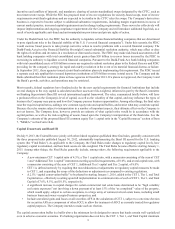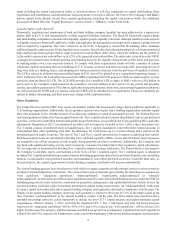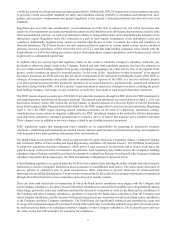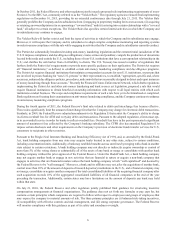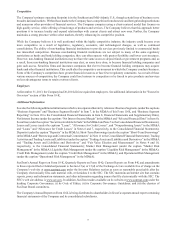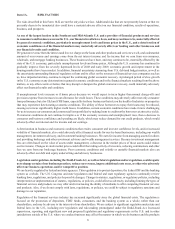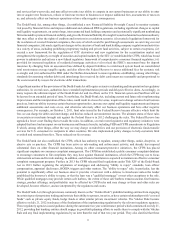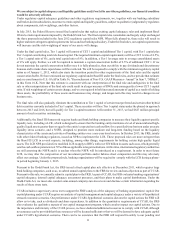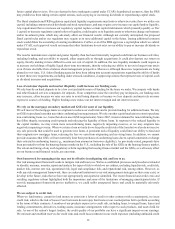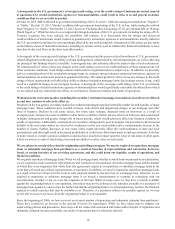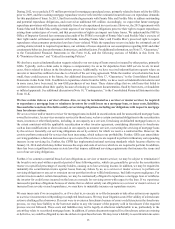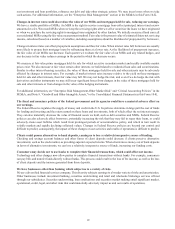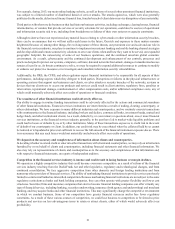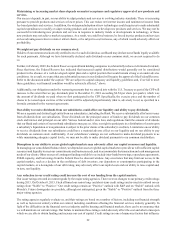SunTrust 2013 Annual Report Download - page 28
Download and view the complete annual report
Please find page 28 of the 2013 SunTrust annual report below. You can navigate through the pages in the report by either clicking on the pages listed below, or by using the keyword search tool below to find specific information within the annual report.12
future capital plan reviews. If we are deemed to have inadequate capital under CCAR's hypothetical scenarios, then the FRB
may prohibit us from taking certain capital actions, such as paying or increasing dividends or repurchasing capital stock.
The Basel standards and FRB regulatory capital and liquidity requirements may limit or otherwise restrict how we utilize our
capital, including common stock dividends and stock repurchases, and may require us to increase our capital and/or liquidity.
Any requirement that we increase our regulatory capital, replace certain capital instruments which presently qualify as Tier
1 capital, or increase regulatory capital ratios or liquidity, could require us to liquidate assets or otherwise change our business
and/or investment plans, which may adversely affect our financial results. Although not currently anticipated, the proposed
Basel capital rules and/or our regulators may require us to raise additional capital in the future. Issuing additional common
stock would dilute the ownership of existing stockholders. Further, even if the FRB approves a capital plan which we submit
under CCAR, such approval would not mean that other limitations do not exist on our ability to pay or increase dividends or
repurchase stock.
The need to maintain more capital and greater liquidity than has been historically required could limit our business activities,
including lending, and our ability to expand, either organically or through acquisitions. It could also depress our return on
equity, thereby making it more difficult to earn our cost of capital. In addition, the new liquidity standards could require us
to increase our holdings of highly liquid short-term investments, thereby reducing our ability to invest in longer-term assets
even if more desirable from a balance sheet management perspective. Moreover, although these new requirements are being
phased in over time, U.S. federal banking agencies have been taking into account expectations regarding the ability of banks
to meet these new requirements, including under stressed conditions, in approving actions that represent uses of capital, such
as dividend increases and acquisitions.
Loss of customer deposits and market illiquidity could increase our funding costs.
We rely heavily on bank deposits to be a low cost and stable source of funding for the loans we make. We compete with banks
and other financial services companies for deposits. If our competitors raise the rates they pay on deposits, our funding costs
may increase, either because we raise our rates to avoid losing deposits or because we lose deposits and must rely on more
expensive sources of funding. Higher funding costs reduce our net interest margin and net interest income.
We rely on the mortgage secondary market and GSEs for some of our liquidity.
We sell most of the mortgage loans we originate to reduce our credit risk and to provide funding for additional loans. We rely
on GSEs to purchase loans that meet their conforming loan requirements. We rely on other capital markets investors to purchase
non-conforming loans (i.e., loans that do not meet GSE requirements). Since 2007, investor demand for nonconforming loans
has fallen sharply, increasing credit spreads and reducing the liquidity of those loans. In response to the reduced liquidity in
the capital markets, we may retain more nonconforming loans, negatively impacting reserves, or we may originate less
negatively impacting revenue. When we retain a loan not only do we keep the credit risk of the loan but we also do not receive
any sale proceeds that could be used to generate new loans. A persistent lack of liquidity could limit our ability to fund and
thus originate new mortgage loans, reducing the fees we earn from originating and servicing loans. In addition, we cannot
provide assurance that GSEs will not materially limit their purchases of conforming loans due to capital constraints or change
their criteria for conforming loans (e.g., maximum loan amount or borrower eligibility). As previously noted, proposals have
been presented to reform the housing finance market in the U.S., including the role of the GSEs in the housing finance market.
The extent and timing of any such regulatory reform regarding the housing finance market and the GSEs, as well as any effect
on our business and financial results, are uncertain.
Our framework for managing risks may not be effective in mitigating risk and loss to us.
Our risk management framework seeks to mitigate risk and loss to us. We have established processes and procedures intended
to identify, measure, monitor, report and analyze the types of risk to which we are subject, including liquidity risk, credit risk,
market risk, interest rate risk, operational risk, legal and compliance risk, and reputational risk, among others. However, as
with any risk management framework, there are inherent limitations to our risk management strategies as there may exist, or
develop in the future, risks that we have not appropriately anticipated or identified. The recent financial and credit crisis and
resulting regulatory reform highlighted both the importance and some of the limitations of managing unanticipated risks. If
our risk management framework proves ineffective, we could suffer unexpected losses and could be materially adversely
affected.
We are subject to credit risk.
When we lend money, commit to lend money or enter into a letter of credit or other contract with a counterparty, we incur
credit risk, which is the risk of losses if our borrowers do not repay their loans or our counterparties fail to perform according
to the terms of their contracts. A number of our products expose us to credit risk, including loans, leveraged loans, leases and
lending commitments, derivatives, trading assets, insurance arrangements with respect to such products, and assets held for
sale. As one of the nation's largest lenders, the credit quality of our portfolio can have a significant impact on our earnings.
We estimate and establish reserves for credit risks and credit losses inherent in our credit exposure (including unfunded credit



